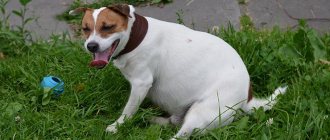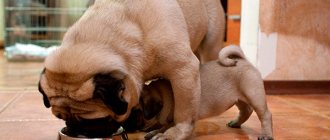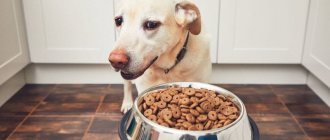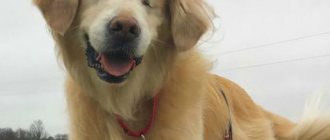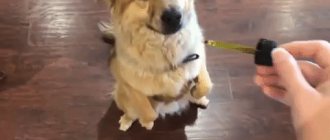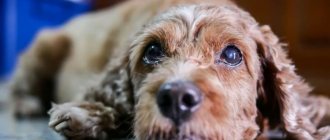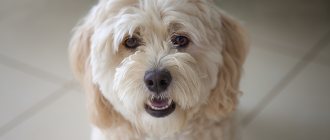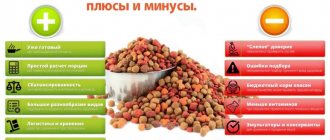Excess weight significantly shortens a dog's life, contributes to the development of a number of diseases and does not add attractiveness. The most common causes of obesity are overfeeding and physical inactivity. The fault for this always lies with the owner. Very rarely the problem is caused by serious illnesses, but even in this case the previous factors are at play.
It's not the dog's fault for gaining excess weight, it's the owner's.
Obesity in dogs leads to the development of:
- Cardiovascular diseases. As body weight increases, the heart works harder and over time begins to fail progressively.
- Diabetes mellitus. The sensitivity of receptors to insulin decreases. Cells stop “seeing” and using the hormone, causing blood sugar levels to rise and diabetes to develop.
- Diseases of the musculoskeletal system. Under excess weight, joints wear out and become deformed faster, causing chronic arthritis, arthrosis, etc.
- Decreased immunity. As a result, susceptibility to infectious diseases increases.
- Decreased reproductive function.
- Load on the liver. Up to the development of fatty degeneration.
- And of course, a decrease in the overall quality of life. Obese dogs find any movement difficult and short of breath, not to mention running after a ball. They become lethargic, spend most of their time sleeping, and have a very difficult time withstanding the heat.
Obesity in dogs: causes, consequences of the disease, prevention and treatment
Many dog owners simply do not notice that they have a problem such as obesity; on occasion, they make fun of their pet’s excess weight, ridicule it, and do not solve the problem.
Obesity, for both humans and dogs, is very dangerous to health and reduces their life expectancy. This problem mainly concerns small breed dogs (Yorkshire Terrier, Chihuahua, Pomeranian Spitz), which is due to their lack of mobility and at the same time they eat well (in most cases they overeat). How can you tell if your pet has a weight problem?
According to the breed standard, a Chihuahua should weigh no more than kg, a Yorkshire Terrier should weigh no more than kg, and a Pomeranian Spitz should weigh up to kg. In the end, this is just a rule to follow, but it is not a 100% way to determine whether your four-legged friend is overweight. A more practical way would be to manually feel the dog while standing, along the back and chest. If you were unable to feel the spine and ribs, but only felt the fat layers, this indicates that the dog is obese. Otherwise, your pet does not have such a problem.
What not to feed
These foods are dangerous to the health of Spitz dogs, never give them:
- pork and other fatty meats (almost indigestible, pork is a source of parasites),
- milk (diarrhea and vomiting are possible),
- bones (shards injure the mucous membranes of the gastrointestinal tract),
- smoked, salted, fried,
- legumes (cause vitamin D deficiency),
- millet, corn (not digested, provokes gastric volvulus),
- pickled, hot, spicy (irritates the stomach walls),
- sweets, flour (leads to surges in blood glucose, obesity and tooth damage),
- chocolate (poisoning),
- stale or with preservatives and other “chemicals”.
Can be given sometimes or with reservations:
- citrus fruits (citric acid irritates the stomach, suppresses the nervous system),
- potatoes (boiled only),
- oatmeal, semolina, barley (if there is no allergy),
- eggs (whole - only boiled, if the yolk is yolk - can be raw).
Causes of obesity in dogs
- Inactivity of the animal. Make a holiday for your pet, take him outside, for him it is true happiness to frolic in the fresh air.
- Binge eating. Any animal must have dosed feeding. If you observe that your pet does not feel moderation in food, limit the amount of food, otherwise it will lead to obesity in the dog.
- Erratic feeding regime. There are people who like to additionally feed the dog all sorts of “goodies” from the table. Remember that most of the foods we eat are not intended for feeding Chihuahuas, Yorkies, and Spitz dogs; they have a detrimental effect on their health. This is a very fast path to obesity. Check out the correct diet and the table of foods that are harmful to small breeds: feeding a Yorkshire Terrier, feeding a Pomeranian, feeding a Chihuahua.
- Unbalanced food.
What are the consequences of obesity in dogs?
Proper nutrition
It is known that a dog should not be fed food from the table. However, many careless owners still cannot learn this rule. Proper nutrition is the key to the health and longevity of your four-legged pet. No matter how busy you are with your daily activities, you must find time to choose complete, high-quality food for your little friend. There are many options on the market today that you can choose from. If you don’t want to buy professional food, then prepare it specifically for your dog. You need to find time for this, even sacrificing your own rest and entertainment. The food should be of high quality, as for yourself. There is no need to save money on a dog, this is a big misconception. Subsequently, treating your pet will cost much more.
Treatment of obesity in dogs
If your dog is obese, it urgently needs to be helped to lose weight, that is, to treat the pet. To prevent and treat obesity in dogs, follow the two main points below.
- Nutrition. The first step you need to start losing weight is to establish a diet and provide the correct diet for your dog. There is no need to mock the animal and go on a hunger strike, just reduce the portion of food by at least 2 times, give up high-calorie (fatty) foods, feed the dog 2 times a day at the same time, do not allow yourself and others (friends, family members) feed the pet with goodies. What foods to feed dogs of decorative breeds, diet and diet, see here: feeding a Yorkshire terrier, feeding a Pomeranian, feeding a Chihuahua.
- Exercise, walks. Many people who have chosen a pet Yorkie, Chihuahua or Spitz rarely go for walks with them, otherwise the dog does not see the street at all and because of this it is inactive, which in most cases is associated with the problem of obesity. Do not rid the animal of such pleasures as walking outside, increase their number and duration. Give your pet the opportunity to run around independently (without a leash), or use active games. There is no need to give your pet maximum physical activity; increase it gradually.
- diet for dogs with obesity
- obesity in dogs symptoms
- dog food for obesity
We are also found by queries:
source
Gaining weight for competitions
If there is an exhibition coming up, and the pet’s parameters do not meet the standards, reduce physical activity and increase the amount of food. Avoid drastic changes in your diet. Show class animals are admitted to the competition only after careful selection. Having access confirms the high quality of their content. Sudden changes can lead to deterioration in coat quality and allergic rashes. Even if you achieve the required kilograms, the prize place will still remain unattainable due to deviations in more serious indicators.
If your pet is going to compete in agility competitions, hunting or other super active activities, it is necessary to increase the calorie content of the food. Each individual breed has its own standards, and a specialist will tell you about them. A well-designed menu is the key to success for a four-legged competition participant.
Dystrophy is fraught with very serious complications. Don't let the situation take its course and seek help at the first signs of weight loss. In most cases, the owner is to blame for malnutrition, so read the recommended feeding rules and regulations for a specific breed before purchasing a pet.
The article is for informational purposes only. Contact your veterinarian!
My Spitz is obese, what should I do?
Everyone shows love for their own Spitz in different ways. One of the most common such manifestations is treating people with all kinds of “goodies.” How can you not pamper your Pomeranian with a piece of cheese or a delicious cookie? Over time, the momentary weakness in front of the dog’s “hungry” eyes becomes far from just a minute, but an hour, a week, and, in general, permanent. And, it seems, every owner knows that systematic feeding will not lead to anything good; it is difficult to fight your own weakness. After all, the dog “has become completely thin, poor thing.”
Time passes and the “emaciated poor Spitz” turns into a bedside table on crooked legs, cannot run for long, breathes heavily and grunts strangely on a hot summer day. You shouldn't be surprised. We have reached you with one of the most common problems not only for people but also for domestic dogs - obesity.
Obesity is not just extra pounds, it is a serious health threat. But before we look at the methods of treating the disease, let’s consider the causes of its occurrence and options for eliminating the problem in its infancy.
There are three main causes of obesity: 1. Overfeeding. Exactly what was said at the beginning of the article. It seems to you that your Spitz is not eating enough. Even after the next feeding, the Pomeranian with a hungry look begs you for a piece of “something else tasty.” You are trying to increase the portion and caloric content of the food, just so that the dog is full. But it was not there! There is an opinion that dogs eat for future use. It is not wrong at all. And many representatives of the tailed nation will eat as much as they give until they “burst.” Hence the illusion that the animal does not have enough food.
Yes, there are dogs that do not finish the allotted portion or refuse to eat at all. Out of harm. Often these are spoiled little impudents. But now it’s not about them.
If you cannot determine on your own what size the daily portion of food for your Spitz should be, you should contact your veterinarian. The doctor, based on the various conditions of keeping the animal, breed and age, will select a suitable diet. Even if you prefer dry food rather than natural feeding, you should not blindly trust what is written on the package. A variety of foods makes it possible to choose the most suitable food specifically for your dog. It is enough to feed your dog one food for a month or two to determine whether it is suitable for her or not. And it’s not just about the coat and the smell from the mouth, but also about maintaining the body at the right weight.
Our dog has become fat! 2. Monotonous lifestyle. Lethargic walks on a short leash are unlikely to help maintain your Spitz's athletic figure. With such a “sofa” lifestyle, even with proper nutrition, excess weight cannot be avoided. If you do not have the opportunity (physical, territorial) to organize daily multi-kilometer races, you can find other ways to provide your dog with exercise. Physical activity is selected taking into account the breed, activity level of the Spitz and your preferences. For some, it’s enough to run after a ball, while others are happy to go out of town on weekends, for bike rides. A great option for a lazy owner and an active Spitz is swimming or going for walks with other dog owners. While you are praising each other about your favorites, the latter are having fun frolicking with each other.
3. Predisposition to obesity. Breeds such as Labradors, Rottweilers, Dachshunds, Pugs and Pomeranians are inherently predisposed to being overweight. If you notice that your Spitz continues to gain weight with proper nutrition and exercise, you should contact a veterinarian nutritionist. There are special foods developed taking into account the breed characteristics of dogs. They help stabilize weight and maintain it within limits. If your Pomeranian is prone to obesity, special attention should be paid to its health. Diabetes mellitus and heart problems are the most common diseases associated with obesity.
How to determine obesity in a dog? There are statistical tables of normal weight for each dog breed. Also, for each breed, weight (as height at the withers and body length) is specified in the standard. All you have to do is weigh your Spitz periodically. The ribs will help you visually determine the fatness of your dog. You can feel the ribs, press your fingers on the sides of the Spitz. If the ribs are difficult to palpate, then you should think about the problem that is arising. External symptoms of obesity are fat pads on the hips, a “duck” gait, shortness of breath, and decreased activity.
What are the dangers of obesity in dogs? Obesity causes great harm to the health of the Spitz. With increased body weight, there is an additional load on the heart. Therefore, Spitz dogs with a predisposition to obesity already suffer from heart disease by the age of four. But this is far from the only problem. Obesity contributes to diseases of the liver, pancreas, and the development of diabetes. Joints and limbs suffer. The dog's lifespan is reduced.
To avoid health problems, it is necessary to maintain normal weight. But what to do if you have already missed this moment and the Pomeranian has become overweight? To return to the required weight, you need to very carefully calculate your diet and increase your load. Gradually. At the same time, you need to consult with your doctor, who will “guide” the Spitz throughout the diet and make sure that it does not affect its health.
Animals, like people, cannot lose weight quickly. This can harm the dog even more, new problems will appear, no better than the old ones. Therefore, if the result is not visible immediately, do not despair, over time the weight will return to normal, activity will increase, and shortness of breath will disappear.
The consequences of obesity and dysfunction of internal organs are eliminated through treatment in combination with diet. Even having achieved the desired result, you will have to monitor the dog’s nutrition and health much more carefully so as not to repeat previous mistakes.
Do you still want to pamper your beloved pet? Buy him a new ball and take him for a longer walk. If your dog is a food eater, treat it once a month with a dried hoof from a pet store. And the best option is vitamins. Both tasty and healthy.
source
Causes of excess weight in dogs
Experts identify several reasons why a dog may develop obesity.
Note! In many cases, excess weight occurs due to the fault of the owner.
Lack of movement
Dogs are active and mobile creatures. Any breed (small Spitz or large retriever) needs long walks. If an animal is taken outside only to relieve its natural needs, then very soon it will begin to gain excess weight.
Excess weight is dangerous for a dog and can lead to the development of many problems.
Poor nutrition
The pet must have a diet. It is recommended to carefully select the appropriate food. If your diet is natural, you should pay attention to good foods with low fat content. In addition, you cannot feed your dog constantly and give it food from the table.
Important! Many owners are touched when the dog happily eats everything and constantly asks for more. However, the animal gradually gains excess weight from overeating.
Sterilization and castration
After such interventions, the animal’s sexual instinct is suppressed, so the dog can direct all its energy to searching for food. In addition, surgery can cause a slowdown in metabolism. Doctors recommend reviewing the diet of animals that have undergone castration or sterilization.
Hormonal disorders
Malfunctions in the hormonal system also lead to a slowdown in metabolism, which can also cause obesity.
For your information! There are also dog breeds that are prone to obesity - pugs, basset hounds. For such pets, it is important to immediately develop a suitable diet.
It is important to choose the right diet for the animal
Features of feeding Spitz dogs of different breeds
An ideal menu for dogs should take into account factors such as the animal’s age, weight, height, physical condition and level of exercise received. Spitz breeds differ only in size, weight, length of muzzles, ears, tail set, hair, and color.
Any nutritional nuances are usually not specifically indicated for breed groups of Spitz. All Spitz dogs are active and prone to overeating due to their small size and increased cuteness.
Of course, the tiny Miniature Spitz, only 18-22 cm tall, has a different daily food requirement than the tall Wolfspitz, 43-55 cm tall! And the Kleinspitz (height 23-29 cm) will eat the same as the larger Middle Spitz and Grossspitz (30-38 and 42-50 cm at the withers, respectively), only in smaller quantities.
Possible health effects
Obesity in animals, as in humans, often causes serious problems in the body. For dogs, excess weight threatens the following pathologies:
- diabetes;
- heart and vascular diseases;
- liver and kidney diseases;
- disruption of the digestive system;
- increased risk of developing problems with the respiratory system;
- hormonal and endocrine disruptions;
- skin problems;
- visual impairment.
In addition, overweight dogs often suffer from sprains, joint and bone diseases, spinal dysfunction, and hip and shoulder dysplasia.
How to find out your ideal weight
The weight of a dog depends on the breed and size. However, sometimes the weight is within the normal range, but the dog is still diagnosed with obesity. To accurately assess your pet’s condition, experts suggest using the following data:
- if your pet’s ribs, bones and spine are clearly visible even from a distance, this indicates a lack of required mass and a deficiency of fat deposits;
- when palpated and examined, the ribs and spine are easily identified, and when viewed from above, a well-defined waist and a tucked belly are noticeable, then we can say that the animal’s weight is below normal;
- upon palpation, the ribs are easily identified, but are not visible, the waist is visible, the stomach is tucked up and not sagging - this is the ideal condition of the pet, the weight in this case is considered normal;
- The ribs and spine are difficult to feel through the layer of fat. When viewed from above, the waist is wide; when viewed from the side, a sagging belly is noticeable. Types of fat deposits on the chest, hips, and tail. This condition indicates that the pet is overweight;
- the presence of significant deposits of fat on the chest, back, at the base of the tail, a heavily sagging stomach, lack of a waist, a wide chest and stomach - such signs indicate obesity.
Note! The ideal weight is calculated by the veterinarian for each dog individually, depending on its characteristics.
The animal must be weighed every week to note changes in weight.
Vaccinations
For the health of the dog, the owner is obliged to take preventive measures in a timely manner. One of these important steps is vaccinations. They need to be done regularly to eliminate possible unpleasant consequences. It would be wisest to consult a specialist about how often they should be placed and at what time. Vaccinations prevent the development of many diseases and reduce the risk of infection several times. If your dog has noticeably lost weight, it would be a good idea to pay attention to this point.
Making a weight loss plan
Before putting your dog on a diet, it is recommended to develop a weight loss plan. At the initial stage, it is recommended to consult a specialist. The veterinarian will conduct the necessary examinations of the animal and clarify exactly how much the animal needs to lose.
An experienced doctor will help you create a diet for the animal, check your pet for any diseases, and recommend the most suitable food.
Important! There are currently medications available to help dogs lose weight. However, such drugs are used only with the permission of a veterinarian and only when absolutely necessary.
Before putting your dog on a diet, it is recommended to create a table in which you enter daily data on food, duration of walks, and weight of the pet.
Is it possible to mix
You can often hear that it is not recommended to change dry food throughout life and not to mix dry food with regular (natural) food. However, many breeders believe that alternating food from natural products with industrial food is acceptable. It’s just important not to mix them into one feeding. It is a mistake to believe that a mixture of porridge and croquettes will give the dog more benefits and fill it up faster.
You can mix wet food with kibble from the same manufacturer. However, there is a drawback - this significantly increases the cost of feeding.
There are canned foods into which it is permissible to add boiled cereals, usually rice porridge or buckwheat. It's written on the cans.
If your pet doesn’t eat one food well, you have to switch to another. This is done gradually. The digestive system does not adapt immediately. It will take several days. On average, the translation process takes a week.
Amount of food
It is important to accurately calculate the required amount of food. You cannot feed your dog constantly; there should be a limited number of meals per day and a calculated portion.
Veterinarians often recommend switching your pet to a special dietary dog food for weight loss. This option will allow you to be satisfied with a small amount of food, but this portion contains all the necessary vitamins and microelements.
For your information! Dietary lines exist from many manufacturers, for example, Monge, Hills, Royal Canin, No, but there are also other premium foods.
What should the diet be like?
“What to feed a dog to make it lose weight?” is a question many owners ask. The diet for dogs with obesity is selected together with a veterinarian. It is recommended to warn all relatives that the dog’s food is limited, and this condition must be adhered to.
A diet for a Chihuahua to lose weight will differ from the diet for large dogs, so you should be careful when choosing a diet.
Note! The animal should not starve, this will lead to negative consequences.
How to lose weight for a Labrador? Large breed dogs are fed 3 times a day, small dogs (Yorkies, Spitz) - 4 times. Older dogs are given food once a day to reduce the load on the pancreas and normalize metabolism, but it must fully cover the dog’s need for all necessary elements.
In order for a dachshund, Yorkshire terrier or other dog breed to lose excess weight, it is important to completely review the diet. If the dog is natural, then fatty meat and fish, baked goods and sweet products are removed. It is better to include more vegetables in your diet, and replace tasty treats with carrots, apples, biscuits and other low-calorie foods. There are many recipes for dietary dog food.
Important! If professional dry dog food for weight loss is chosen for the diet, then the specified dosage and number of feedings must be strictly observed.
List of permitted and prohibited products by category
List of main products:
- meat (veal, lamb, turkey);
- offal (stomach, heart, tongue, tripe);
- cereals (buckwheat, rice, wheat, corn porridge, oatmeal);
- vegetables (carrots, zucchini, pumpkin, beets, cabbage);
- fruits (apple, banana, persimmon, melon, pear, apricot);
- greens (dill, parsley, green onions);
- vegetable oil (sunflower, olive, flaxseed);
- fermented milk products (cottage cheese, kefir, natural yoghurts, curdled milk);
- fish (oceanic and sea);
- seafood (crabs, squid, seaweed, mussels);
List of unacceptable products:
- bones;
- fatty meat (lard, lamb, pork;
- semolina, millet porridge and barley.
- milk (acceptable for puppies under 3 months);
- sausage;
- garlic, onions;
- salty, hot, smoked, spicy;
- potatoes, raw cabbage;
- strawberry;
- citrus;
- sweets.
Physical exercise
All dogs love walks and games. If at the initial stage it is difficult for the animal to move quickly, then it is necessary to at least increase the walking time. Active games and jogging are gradually added. Small breed dogs should be handled as little as possible so that they can move independently. You can take animals out into nature; the presence of new sounds and smells will interest the dog, and it will forget about laziness. There is no need to immediately try to force the dog to build muscles, it is important that he enjoys it.
Exercise is good for any animal
What not to do
There are a number of actions that are unacceptable while your pet is on a diet:
- You cannot limit your dog to water, it is dangerous for his body;
- It is necessary to initially collect all the information about treats, some products can be toxic to dogs;
- Excessive physical activity is also not always suitable for the animal. It is recommended not to strain your pet too much in the initial stages.
You cannot deprive your dog of food completely; the process of losing weight should be gradual.
Practical advice from experts
Experts recommend monitoring your dog’s diet from childhood so that the pet develops normally. It is important to choose the right diet for the dog, regularly provide it with physical activity and in no case overfeed it.
Important! Giving goodies from the table is also wrong; it is better to buy special products that contain little sugar but more fiber.
If your dog is overweight, it is recommended to consult a veterinarian to develop an appropriate menu. We should not forget about physical activity and walks, which will help you lose weight faster. Excess weight can cause many diseases and problems in the body, so it is important to monitor the condition of your pet.
source
Sample menu for the week
The daily diet of oranges should include:
- meat and offal (30-60%);
- vegetables and fruits (20-50%);
- cereals (20-40%);
- fermented milk products (from 20% and more).
| Day of the week | Menu |
| Monday | Cereals (wheat, corn porridge), meat (veal, lamb), fruits (apple, melon). |
| Tuesday | Fermented milk products (kefir, yogurt), offal (stomach, tripe), herbs (dill, green onions). |
| Wednesday | Cereals (buckwheat, rice), seafood (crabs, seaweed), meat (veal, lamb, turkey). |
| Thursday | Fermented milk products (cottage cheese), fish (ocean or sea), vegetables (carrots, zucchini, beets). |
| Friday | Fermented milk products (cottage cheese, natural yoghurts), meat (turkey), fruits (banana, persimmon, pear). |
| Saturday | By-products (heart, tongue), vegetables (pumpkin, cabbage), meat (lamb, turkey), herbs (dill, parsley). |
| Sunday | Cereals (oatmeal), fish (ocean or sea), fruits (banana, apricot). |
